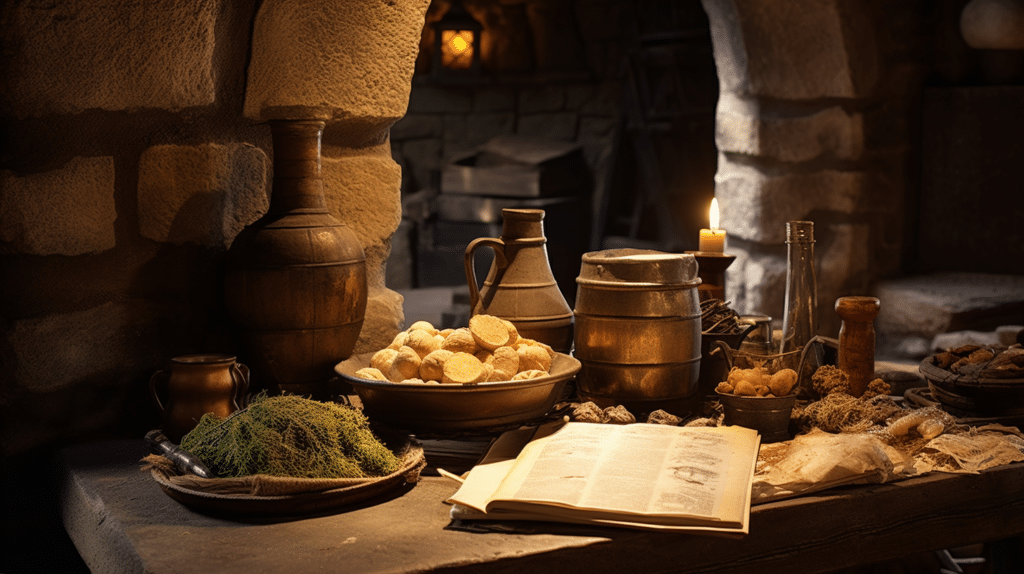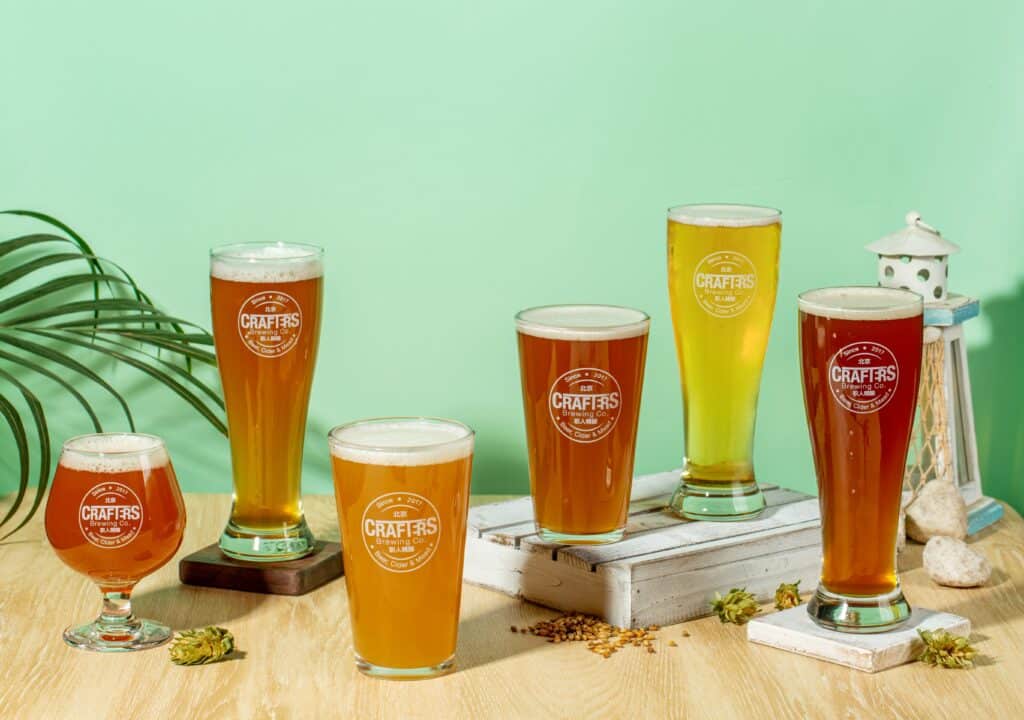Disclaimer: This post may contain affiliate links, from which I may earn a small commission at no extra cost to you. Thank you for supporting Ale Affair.
Embark on a nostalgic brew quest to discover what they drank in the Middle Ages by recreating the authentic taste with medieval ale. This age-old beverage is a testament to the brewing craftsmanship of yesteryears, offering a rustic yet hearty flavour profile that defies the sands of time. Learning the art of crafting this age-old brew is a venture into the past, reviving the traditional techniques and ingredients that once quenched the thirst of medieval folk. The simple process of infusing barley, water, and a blend of age-old herbs known as gruit, then fermenting the mixture to perfection, yields a brew that transports you back to the medieval taverns with every sip. This exploration doesn’t just satiate your taste buds but also delves into the history surrounding alcohol in the medieval era, setting the stage for a brewing adventure that is as enlightening as it is flavourful. Our journey begins with understanding the essence of medieval brewing, a tradition steeped in time, awaiting the modern brewer’s rediscovery.
The Medieval Brewer’s Craft: Alcohol in the Middle Ages
Step back in time to the bustling taverns of medieval Europe, where ale flowed generously, acting as a vital part of daily sustenance. During the medieval era, ale was more than just a leisurely beverage; it was a liquid bread, providing essential calories and nutrition to nobles and peasants alike. The medieval brewer held a prestigious position, turning simple ingredients into hearty ales that warmed the spirit and fuelled the community.
The distinctiveness of medieval ale lies in its traditional brewing methods, deviating from modern-day practices. The omission of hops, a now-common ingredient, and the inclusion of gruit, a blend of herbs and spices, crafted a unique flavour profile that defined ale in the Middle Ages. Gruit brewing, a practice predating the widespread use of hops, enriched the ale with a complex bouquet of flavours while acting as a preservative, embodying the ancient art of brewing beer in medieval times.
Beyond the blend of barley, water, and gruit, the technique employed by the medieval brewer was an artistry of its own. The brewing process was meticulous, honed over centuries, capturing the essence of a bygone era in every sip. With rudimentary equipment and a deep understanding of natural fermentation processes, these ancient brewers mastered the craft amidst a world devoid of modern conveniences, encapsulating how ale was made in medieval times.
The cultural significance of alcohol in medieval times is profound. It was a social lubricant, a currency, and a symbol of hospitality. The brewing tradition was interwoven with the fabric of society, encapsulating the era’s communal spirit and technical ingenuity.
As we venture further into medieval brewing, the mystique of gruit and its role in crafting the authentic taste of medieval ale unfolds. Our exploration into gruit brewing reconnects us with the ancient brewing heritage. It sets the stage for recreating the cherished medieval ale in our modern-day brew kettle.
Gruit Brewing: The Heart of Medieval Ale Alcohol Content

As the doorway to the rich, herbal world of medieval ale, gruit brewing holds the essence of a time when beers boasted a botanical panorama of flavours. Gruit, the blend of herbs and spices, was the medieval brewer’s signature, defining the distinctive taste and alcohol content of ale in the medieval era. Unlike the hop-dominated brews of today, medieval ale embraced a herbarium of tastes, from the sweet whispers of yarrow to the earthy notes of heather.
Exploring gruit brewing unveils the ancient practices that shaped the very identity of medieval ale and how medieval beer recipes reflected the local terroir. Gruit brewing was more than a mere tradition; it was a legal and commercial enterprise. The land’s rulers regulated the sale of gruit, often a source of revenue and a means to control the quality of ale. This regulatory context highlights the importance of gruit brewing in medieval society and economy.
With the knowledge of gruit brewing, we now transition to the practical art of crafting your own medieval ale recipe, reviving the timeless tradition of the medieval brewer.
Crafting Your Medieval Ale: A Journey from Medieval Beer Recipe to Glass
Embark on a historical brewing adventure with this guide to crafting your own medieval ale. This recipe, inspired by traditional medieval beer recipes, yields approximately 19 litres (5 gallons) of ale, embodying the rustic essence of the medieval era.
Ingredients
– 5 kg Pale Malt (2-row)
– 500 g Crystal Malt
– 500 g Wheat Malt
– 30 g Bog Myrtle (Sweet Gale)
– 30 g Yarrow
– 30 g Marsh Rosemary (or substitute with common Rosemary if unavailable)
– 1 packet of ale yeast (such as Wyeast 1099 Whitbread Ale)
Instructions
1. Milling and Mashing (1-1.5 hours):
– Mill the malts to break down the grains, making the sugars more accessible.
– Mix the milled malts in a mash tun with hot water (around 75°C) to achieve a mash temperature of about 65°C.
– Maintain this temperature and allow the mash to rest for 60 minutes to allow the enzymes to break down the starches into sugars.
2. Lautering (1-2 hours):
– Separate the liquid from the grains using a straining or sparging process, ensuring to extract as much sugar from the grains as possible.
– Add the liquid, known as wort, to your brew kettle.
3. Boiling and Infusing (1 hour):
– Bring the wort to a rolling boil.
– Add your gruit herbs and maintain a rolling boil for about 60 minutes, allowing the herbs to infuse their essence into the wort.
4. Cooling (30-45 minutes):
– Cool the wort rapidly to around 20°C using a wort chiller or an ice bath to prevent bacterial contamination.
5. Fermentation (1-2 weeks):
– Transfer the cooled wort into a sterile fermentation vessel.
– Pitch the yeast into the wort, seal the vessel, and allow it to ferment at a consistent temperature of around 18-20°C.
6. Bottling (2-3 hours):
– After fermentation, transfer the ale into sterilised bottles, leaving an inch of headspace from the top.
– Cap the bottles and store them in a cool, dark place for at least two weeks to carbonate and mature.
7. Tasting:
– After allowing your ale to mature, pour it into a glass, leaving any sediment behind in the bottle.
– Enjoy the traditional, herbal flavours of your homemade medieval ale!
Practical Tips:
- Ensure all your brewing equipment is thoroughly sanitised to prevent unwanted bacterial infections.
- Consider sourcing your gruit herbs from reputable suppliers or local foragers to ensure authenticity and quality.
- Patience is vital, especially during the fermentation and maturation stages, as rushing these processes could detrimentally affect the flavour and quality of your medieval ale.
Summary
Embark on a historical brewing adventure with our guide on how to make medieval ale, a tribute to the robust brews of the Middle Ages. Discover the essence of medieval brewing with traditional gruit herbs, capturing the rustic and hearty flavours that defined the ale of yesteryear. This journey, from sourcing authentic ingredients to savouring your homemade medieval ale, not only revives ancient brewing traditions but also offers a tangible connection to medieval times’ vibrant and communal spirit. Whether you’re a brewing novice or a seasoned ale enthusiast, crafting medieval ale is a rewarding voyage through time, with each sip resonating with echoes of the past.




